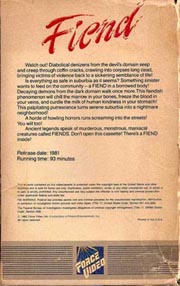Reviews
Don Dohler
USA, 1981
Credits
Review by Leo Goldsmith
Posted on 26 October 2008
Source Force Video VHS
Categories 31 Days of Horror V
Seville County, March. The camera tracks through a solitary country graveyard as pines sway malevolently. Without warning, across an unconvincing day-for-night sky, floats a diaphanous red blob, a quivering specter resembling nothing so much as a spermatozoon with spindly, hook-shaped arms. This, the foreshortened typeface tells us, is a “FIEND,” and before long it delves underground to unearth a body with which it can strangle people.
It’s a shame, in some ways, that this fiend - hungry as it was to assume human form - couldn’t find a better-looking corpse, as surely there were more attractive people buried in the Seville County graveyard. Director Don Dohler - or someone else with a thing about words beginning with “D” - describes his titular fiend as “Dark… Deadly… Demonic” on the film’s VHS packaging. Once in its bodily guise, played by Don Leifert and known as “Mr. Longfellow” to his neighbors, this fiend is also Doughy … Drooping … Dandyish. Clad in black, sporting dyed-black helmet-hair and a handlebar mustache, Mr. Longfellow doesn’t seem so much deadly and demonic as pretentious and dorky, an insufferably haughty guy and inconsiderate suburban neighbor who occasionally becomes grotesquely flaky-skinned, glows red, and kills people in order to rejuvenate himself.
The precise logic of Fiend is somewhat hazy, but here is what I can make out from its sketchy narrative arc and cursory skimmings of demonology: A fiend is some kind of formless red sperm, like that seen in the opening sequence, that floats around looking for a sympathetic vessel—in this case, a deceased music teacher named Mr. Dorian. Once in this (deceased) body, the fiend demands a regular diet of wine and human lifeforce, which it extracts from its victims through glowing red hands during strangulation. And in order to maintain this existence, the fiend must move into a split-level tract home in a Midwestern suburb, get a black(ish) cat, and spend as much time in his rec-room/cinder-block-lined lair as possible. But for his residence in a heavily populated family cul-de-sac, one might assume that the fiend is by nature reclusive. In fact, he seems to relish a certain amount of social interaction, maintaining a steady job as an abusive violin teacher, orating condescendingly to his neighbors, and bullying (and later, predictably killing) his employee, Mr. Frye.
Despite incessant claims that he wants to be left alone, and his occasionally menacing (and on one occasion, murdering) the neighborhood children, the fiendish Mr. Longfellow only really exhibits antisocial behavior when his supply of human lifeforce is depleted. Pale, leprous, and scabby, black hair-dye streaked with white, the hungry fiend seeks sustenance: cruising the parking lot of the local A&P, following people through the woods, and incautiously strangling people in what is nearly always broad daylight. This all seems to work pretty well for Longfellow until his bloodlust leads him to take the young life of Little Christy Michaels, an innocent playing with her dollies, in what is basically his own backyard.
Amazingly, though Longfellow’s alibi is by no means watertight and his demeanor far from sympathetic, no one seems to suspect his involvement except for Gary Kender, Longfellow’s Pabst-sipping next-door neighbor, who also has a mustache, as well as a mullet. Though Gary’s wife Marsha is less certain about Longfellow’s guilt - “I think you’re just picking on the man because he plays the violin and you don’t like him” - Gary begins a plodding, unsubtle, and head-smackingly imperceptive investigation of his own. A visit to Longfellow’s subterranean bachelor pad (Gary, combatively: “It’s kind of cold and damp down here, isn’t it?” Longfellow, imperiously: “I prefer it that way.” Cue creepy music); an inspection of his collection of mangled photographs of his recent victims; a brief examination of the Satanic kitchen knife that Longfellow keeps in an ornate box in his shrine: all of these turn up no clues to the true identity of the murderer of Little Christy Michaels. Even when Gary learns that Longfellow’s cat - not exactly black, it has a cute white muzzle and paws - is named Dorian, he fails to connect this to the “grave robbery” in Seville County some months prior.
But clever plot-twists are not what Fiend is about—Fiend is about fiendishness, and on this point, the film delivers, albeit at bargain prices. To be sure, the film’s budget probably did not allow for the procurement of a cat that is totally- black, or for shooting in locations other than friends’ houses. Granted: the musical score by Paul Woznicki (misspelled “Wozmicki” on the VHS case) is the product of randomly hitting buttons on a Roland Jupiter-4; Richard Geiwitz’s cinematography is an inept mixture of awkward framings, constant and unmotivated zooms, and lots of bumpy tracking; and it’s entirely likely that the principal ingredient in Mark Supendsky’s monster makeup is pancake batter. But in spite all these elements - and a consistently fascinating array of 1980 fashions and interior stylings - Don Dohler’s film is nothing if not fiendish. It practically sweats fiendishness through its dreadful, dry, desiccated skin.
More 31 Days of Horror V
-
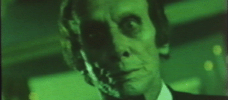
The Dead Don’t Die
1975 -
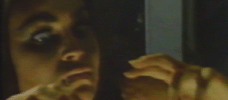
The Brides Wore Blood
1972 -
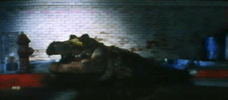
Alligator
1980 -
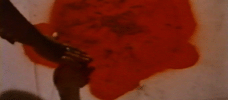
Girl in Room 2A
1973 -

Zombie High
1987 -
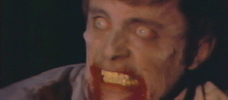
Deathdream
1974 -

Link
1986 -

The Witching
1972 -
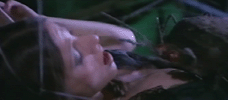
Nude for Satan
1974 -

Rock ‘n’ Roll Nightmare
1987 -
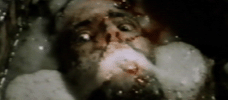
The Strangeness
1985 -
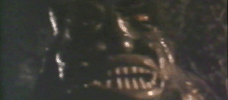
Brides of the Beast
1968 -
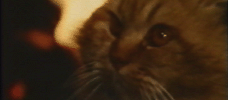
Seven Deaths in the Cat’s Eye
1973 -
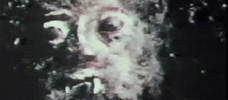
The Curse of Bigfoot
1976 -
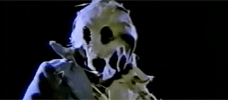
Dark Night of the Scarecrow
1981 -

Chopping Mall
1986 -

The Jar
1984 -

Killer Workout
1986 -

Moon in Scorpio
1987 -
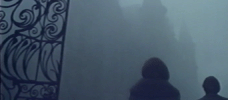
The Legend of Hell House
1973 -
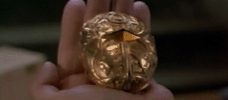
Cronos
1993 -

Black Christmas
1974 -
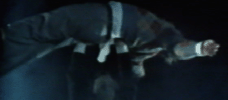
Grave of the Vampire
1974 -

Rana: The Legend of Shadow Lake
1975 -

Blood Voyage
1976 -

Fiend
1981 -

Anguish
1987 -
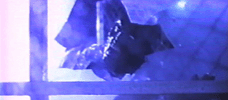
The Chilling
1989 -

Attack of the Beast Creatures
1985 -
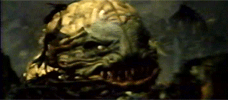
Humanoids from the Deep
1980
We don’t do comments anymore, but you may contact us here or find us on Twitter or Facebook.




